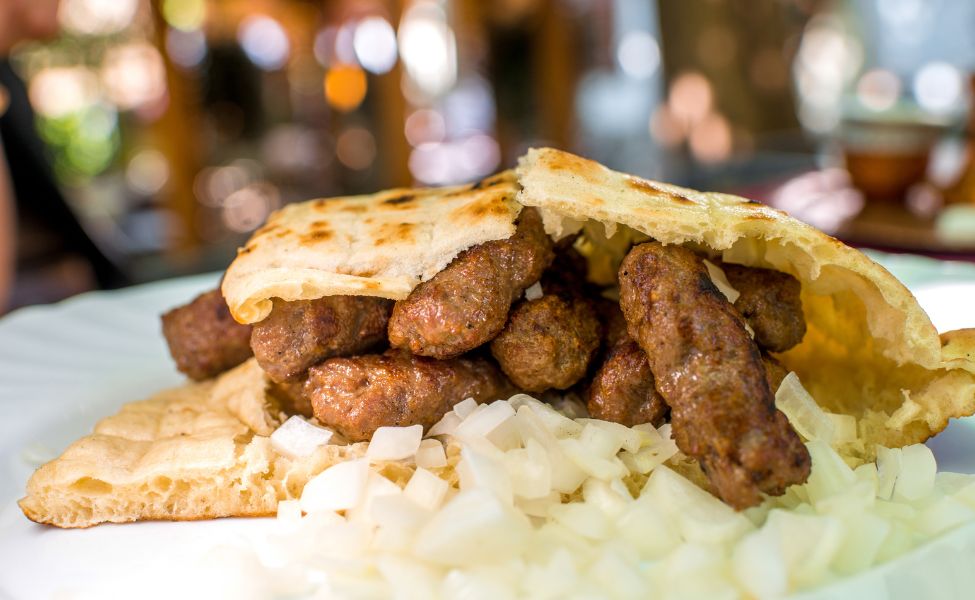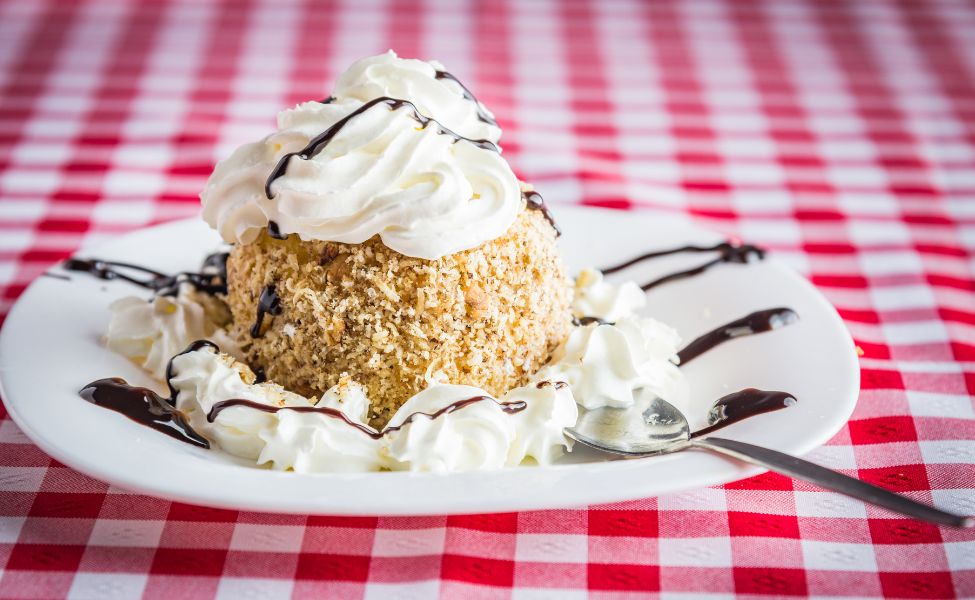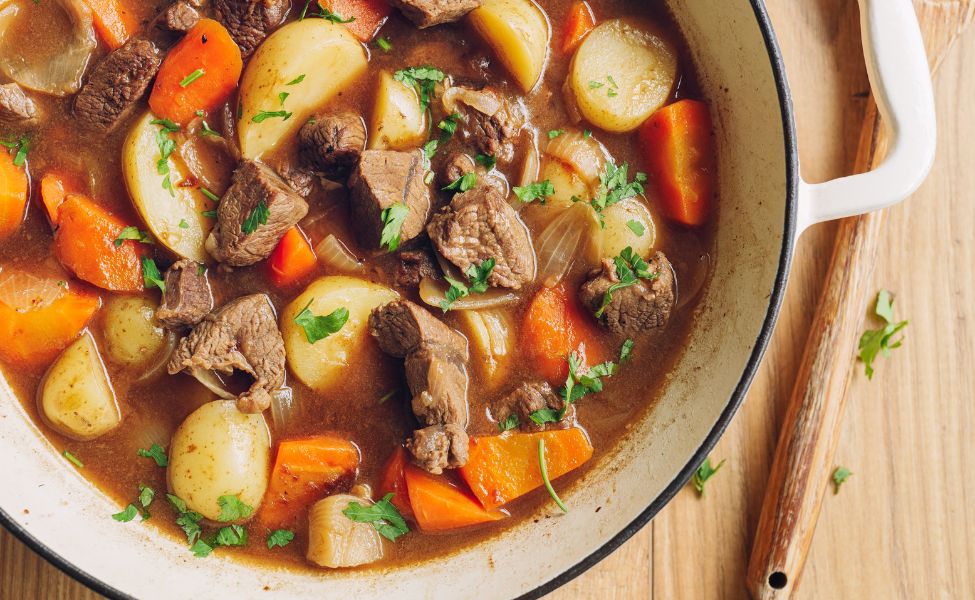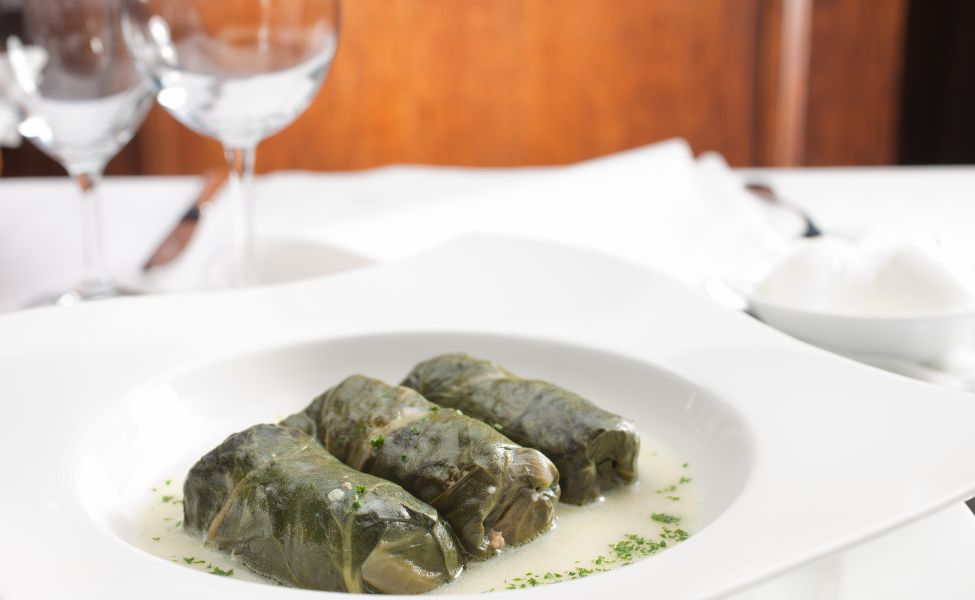If you want to give your palate and stomach a treat, you should head out to Bosnia and Herzegovina. Three nations, two entities, one district, different religions, attitudes, and lives, but all have one thing in common - love for food. Food has a special significance here, and Bosnian recipes are passed down through the generations. Sometimes in its original form, sometimes with a bit of a modern kick to it. Some of the things we'll go through together are:
- What is Bosnian food known for?
- Ćevapi - Best of the Bosnian meats
- Traditional Bosnian Food - Unique Bosnian recipes to try
Source: ©Jana_Janina from Getty Images via Canva.com
What is Bosnian food known for?
Over the years Bosnian cuisine has taken on the influences of oriental, Mediterranean, and Western cuisines. Traits of Turkish, Austro-Hungarian, Arabian and Jewish cultures and cooking practices are noticeable in almost every bite. Meals in Bosnia and Herzegovina can look something like this:
- The longer, the better: Recipes with long cooking and brining process are typical of Bosnian food. Dishes are cooked for hours and days in their own juice, with a bit of seasoning that still allows the food to retain its original taste and smell. And, for Bosnian cuisine, the preparation of dishes under the sac (peke) is specific, whereby the food is covered with a metal bell and prepared on the grill.

- Typical ingredients: Tomatoes, potatoes, onions, garlic, peppers, cucumbers, carrots, cabbage, mushrooms, spinach, squash and beans, meat, and dairy products are at the heart of Bosnian cuisine. Spices also play a significant role; you can expect some dishes to be noticeably spicy.
- Everything starts with good coffee: A good cup of dark coffee is appreciated in Bosnia. Freshly grounded coffee grounds are what makes the so-called Turkish coffee taste that special. Its served in small cups with a side of Turkish delight to make your day even sweeter.
- All those pies: Bosnians are known to make the best pies in the Balkans, as they know their dough and filling. Expect to have the juiciest, greasiest (but in a good way) and crunchiest pies of your life. Made with filo or handmade dough, Bosnian pies are usually filled with meat, crumbled cheese or greens.

Most popular Bosnian Specialities - Staples of Bosnian Cuisine
Depending on the area of Bosnia and Herzegovina, the cuisine also differs somewhat. What is known in all parts are kebabs, sarma, burek and traditional delicacies: tufahi, baklava, chape and many others. We will go through each dish together, you will also find out where you can try them these days.
Ćevapi - Best of the Bosnian meats
The most famous dish and, we would say, this country's brand is ćevapi or ćevapčići. Kebabs originally came from Turkey in the 20th century, but local chefs perfected and adapted them so much that they created an authentic specialty. Bosnian cevapcici are best served in a bun with onions. A Balkan type of cheesy spread called kajmak or ajvar is recommended as a side, and you shouldn’t skip them.

You can find great kebabs throughout Bosnia and Herzegovina, but these three regions stand out.
- Ćevapi from Banja Luka: Banja Luka ćevap is one of the first associations with this city, significantly different from Travnik and Sarajevo. These kebabs are made together in slabs with 4 kebabs each so that the meat remains juicy. According to many, you can eat the best kebabs in juicy buns in Banjaluchanka restaurant - one of the oldest restaurants in Banja Luka, located in the Obilićevo settlement; At Muja - this restaurant, which has been nurturing this tradition since 1923, is synonymous with good kebabs; Zlatna Kruna is a restaurant with a long waiting list, but is so worth it.

- Travnik ćevapčići: On the other hand, when you ask people from Travnik, they will tell you that their kebab is the best. We won't judge, but we will tell you that there is a difference in them, and it is reflected in the juiciness and wetness of the bun itself. In addition, the main difference is in the preparation of kebabs, in that here each piece is served separately, not in plates. When you find yourself in Vlašić, visit "Ćevabdžinica Hari", the oldest čevabdžinica Bosna in Travnik, and many others in these areas.
- Ćevapi from Sarajevo: And finally, when you pass through Baščaršija, you won't be able to resist the smells. Namely, the whole street smells like kebabs. According to the recipe, a slightly less juicy bun is made, and kebabs are served inside a bun that has not been cut all the way. The first location for the best kebabs in Sarajevo is "Ćevabdžinica Željo at Baščaršija", followed immediately by "Ćevabdžinica Ferhatović".

Burek - King of Bosnian pies
So, what’s the difference between a pie and burek? If you ask Bosnians, burek is only with meat. It is a flaky dough filled with minced meat, usually pork, served with a tall glass of yogurt. Although the first burek in this region of Europe arrived in Nis in 1498, the inhabitants of Bosnia and Herzegovina perfected it and made it one of the most famous meals. Modern variants, such as pizza or Nutella burek, are becoming increasingly popular, but Bosnia people mostly consider it an abomination. Even though it’s considered a breakfast food, you’ll be able to find fresh burek almost everywhere around Bosnia throughout the day. Some of the best places to eat burek are "Bosna" Sarajevo - This is one of the most popular pubs in Sarajevo, located in Baščaršija and "Bon Apetit" Trebinje - A bakery known for its barrels, pies, and pastries. It is located in the Luč settlement near Trebinje.

Sarma
Sarma is also one of the most famous dishes in the whole of Bosnia and Herzegovina. Originally a Turkish dish, it is prepared in numerous ways, especially in the east and southeast of Europe. The base of the dish is minced meat and pickled cabbage, mostly beef or a combination of pork and beef. Minced meat is prepared with spices and rice; later, the cabbage leaves get stuffed with it and rolled almost like a tight burrito. It’s prepared in big pots, covered with aged meat and bacon, and cooked for a couple of hours.You can try Sarma in almost every traditional restaurant in Bosnia.

Bosnian desserts
When it comes to sweets, Bosnians know what they’re doing. You will be able to find traditional Bosnian desserts on the streets, in cafes, pubs, and even fancy restaurants. From handmade pastries to thick sugary syrups, these three are some of the most famous desserts to try in Bosnia:
- Baklava: A dessert made from thin sheets of dough called jufke, coated with melted butter and stuffed with the ground and chopped nuts. Traditional Bosnian baklava is filled with walnuts, but all over the world, you could find baklavas with pistachios, almonds, and all sorts of creams. To make it extra special, it’s cover with a sugar and lemon syrup, which makes it that juicy.
- Tufahije: This may sound strange, but give it a chance. It’s made from apples that get peeled, carved, and cooked. The center of the apple then gets filled with ground walnuts or almonds, sugar, and sweet cream.
- Šape: The name comes from its shape, as it’s made to resemble a bear’s paw. Sape essentially are crunchy sugar cookies served to guests as a little snack to go with their coffee or tea. Be careful if you have a nut allergy, as they usually contain walnuts.

Traditional Bosnian Food - Unique Bosnian recipes to try
Apart from kebabs and pies, Bosnia has other interesting recipes to brag about. Let us go on a tour of Bosnia, Herzegovina and Krajina, getting to know the specialties of each area and spots that prepare it best.
Mediterranean specialties of Bosnia and Herzegovina
Neum is the only coastal town of Bosnia and Herzegovina, which is where to go if you love seafood. Apart from classic seafood specialties, such as octopus, prawns, and clams, only in Neum do you have the opportunity to try prstaci, or date mussel. This type of shell grows deep in the rocks, and it takes at least ten years to grow one centimeter! Therefore, most of these shells that end up on the plate are about 100 years old.
Precisely for this reason, you will find this delicacy only in Neum, as it is prohibited in most regions of the EU. A kilogram of date mussels in Neum costs from 100 to 120 KM (up to $65), while a portion in a restaurant can cost you around 30 bucks. Restaurants known to serve the best mussels in Neum are Galeb, Bonaca, and Maestral.

Sarajevo or Travnik - Who has the most special Bosnian recipes?
As we climb the map of Bosnia and Herzegovina, we reach the area of Mostar and Sarajevo. Get ready to eat loads of meat and pies, and maybe postpone that clean eating month you’ve had planned. Take note of the best dishes and restaurants to try them at.
Food of Sarajevo
One of the most famous old dishes that are prepared today is the Bosnian pot. Bosnian pot originates from the minds of Bosnian miners. It is prepared in an earthen pot for five to six hours on low heat. To get the full authentic experience, you should eat it directly from the pot. It is made from beef, potatoes, red onions, garlic, green beans, carrots, parsley, celery, tomatoes, white wine, and apple cider vinegar. However, people usually say that Bosnian pot is prepared from everything found in the kitchen.

There is also sogan dolma, another unusual traditional Bosnian dish. It is an onion stuffed with meat. And you can’t say you’ve been to Sarajevo if you haven't tried the veal under the sach. Although it is prepared equally well in all regions, people of Sarajevo follow a special recipe that consists only of meat, potatoes, garlic and oil. Once it’s been cooked for hours it will just melt in your mouth. In addition to the ones listed, there are also moussaka, pilaf, chimbur, different types of bread, pastries, and cakes, but we won’t spoil everything.
Travnik
If the road takes you to Vlašić and Travnik, stop to try the specialties of this region. Cevapcici from Travnik are the best Bosnia has to offer, as it is prepared with a lot of love and according to the unique recipes. In addition to kebabs and grilled dishes, beg's soup is famous here. This flavorful chicken broth can cure anything, we are sure of it. The best bowl of Beg’s soup is served in Divan restaurant, which is located on the ground floor of the Memorial Museum of Ivo Andrić's birthplace.
And now - cheese. Two of the most famous cheeses of Travnik are Travnički and Vlašićki. Although some people think that it is the same cheese, the truth is that Travnički cheese is made from cow's milk, while Vlašićki from sheep's.

Specialties from Herzegovina
Herzegovina produces all sorts of cheeses, meats, locally grown vegetables. One of the variations of sarma that is very popular in this region is japrak, which constitutes cabbage with vine leaves. These are served with sour cream and made to be smaller. Herzegovina is also known for its dried and aged meats. The traditional preparation of dried meat for the long cold winters has been preserved from oblivion and is still prepared according to the method used since ancient times. Prosciutto is made from pork, and dried beef, dried mutton, and sausage are indispensable on the tables of the people of this region.

One region of Herzegovina you shouldn’t miss if you like cheese is Trebinje. Trebinjski cheese is the best there is; it can be bought in farmers' markets and will cost you around 7 KM (around $3). Its organic production makes it healthier than its alternatives. Another fun cheese to try is cheese in oil. A century-old recipe, mountain milk, tradition, and love are woven into the famous Livan cheese. If you ever find yourself near Livno, you must try this homemade eco cheese.
Traditional dishes in Krajina
Many traditional dishes from this area are similar to Serbian food, which you can read more about in our blog - Traditional Serbian food. One of the specialties prepared for Christmas is cicvara. This dish has been prepared since ancient times in areas inhabited by Serbs, and it essentially is just a mixture of low-budget cheeses, kajmak, and cornflower. One of the top dishes to try in this part of Bosnia and Herzegovina is Krajiške pole. It is actually a potato cut in half, salted, and baked in the grill and in the oven. The halves are then covered with thinly sliced bacon, cream, and cheese. You can’t say no to that! Prepared according to a secret recipe - Trappist cheese is Krajna’s brand. It originated in 1882 in the Trappist monastery "Maria Zvijezda" near Banja Luka. Even today, the recipe is kept a secret.

Thanks to the history that took place in this area, Bosnian cuisine is rich in flavors and aromas that will make you want to eat here every day. People here value food and bring it to every gathering and celebration. Which of these food specialties from Bosnia are you most excited to try?



